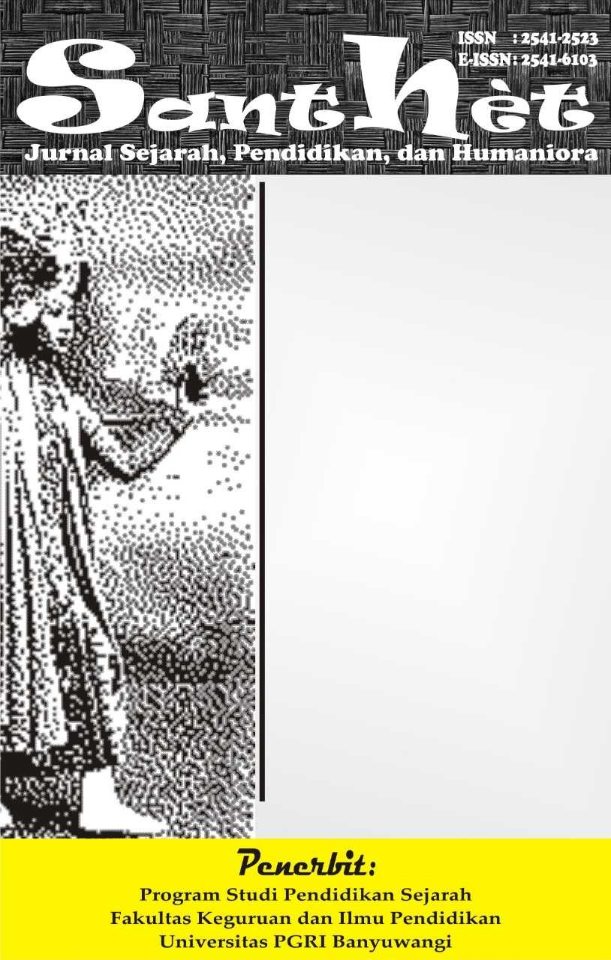Literature Review: Psychological Risk Factors for Suicide Among Prison Inmates
Literature Review: Faktor Psikologis Risiko Bunuh Diri Narapidana
DOI:
https://doi.org/10.36526/santhet.v8i2.4808Keywords:
Faktor psikologis, narapidana, risiko bunuh diri, prison, literature reviewAbstract
Penelitian ini membahas faktor psikologis yang berkontribusi terhadap risiko bunuh diri di lembaga pemasyarakatan (Lapas), fenomena yang menjadi perhatian penting namun kurang diteliti di Indonesia. Artikel ini menggunakan metode tinjauan pustaka, di mana mengkaji 12 jurnal dari berbagai negara dalam kurun waktu 10 tahun terakhir. Hasil analisis menunjukkan bahwa faktor internal seperti gangguan kesehatan mental, trauma masa kecil, dan isolasi sosial, serta faktor eksternal seperti keterbatasan akses layanan kesehatan mental dan kondisi lingkungan Lapas yang padat, menjadi pemicu utama. Artikel ini menawarkan kebaharuan dengan mengintegrasikan temuan internasional yang berfokus pada pendekatan rehabilitasi narapidana. Selain itu, menyarankan peningkatan akses terhadap layanan kesehatan mental di Lapas, penguatan program rehabilitasi, dan deteksi dini risiko bunuh diri sebagai langkah preventif. Upaya ini diharapkan mampu mengurangi risiko bunuh diri dan meningkatkan kesejahteraan psikologis narapidana.
References
Banwell-Moore, R., Tomczak, P., Wainwright, L., Traynor, C., & Hyde, S. (2022). ‘ The human toll’ : Highlighting the unacknowledged harms of prison suicide which radiate across stakeholder groups. Incarceration, 3(2), 1–20. https://doi.org/10.1177/26326663221097337
Bronfenbrenner, U. (1986). Ecology of the family as a context for human development: Research perspectives. Adolescents and Their Families: Structure, Function, and Parent-Youth Relations, 22(6), 723–742. https://doi.org/10.1037//0012-1649.22.6.723
Budiasti, P. P., & Setyawan, I. (2019). Pengalaman Narapidana Wanita Pelaku Pembunuhan di Lembaga Pemasyarakatan Perempuan Klas Iia, Semarang. Empati, 7(4), 206–215.
Citriadin, Y. (2020). Metode penelitian kualitatif (suatu pendekatan dasar). In Lubna (Ed.), Sanabil Creative (1st ed.). Sanabil. http://www.academia.edu/download/35360663/METODE_PENELITIAN_KUALITAIF.docx
Cohen, S., & Wills, T. A. (1985). Stress, social support, and the bufferinghypothesis. Psychological Bulletin, 98(2), 310–357. https://doi.org/10.1037/0033-2909.98.2.310
Durkheim. (2005). Suicide. In the Taylor & Francis e-Library. Routledge classic. https://doi.org/10.1097/00001504-200003000-00002
Erikson, E. H. (1993). Childhood and society. In Journal of Materials Science: Materials in Medicine (Vol. 18, Issue 6). The Hogarth Press. https://doi.org/10.1007/s10856-007-0140-3
Favril, L., Shaw, J., & Fazel, S. (2022). Prevalence and risk factors for suicide attempts in prison. Clinical Psychology Review, 97(January), 102190. https://doi.org/10.1016/j.cpr.2022.102190
Gétaz, L., Wolff, H., Golay, D., Heller, P., & Baggio, S. (2021). Suicide attempts and covid-19 in prison: Empirical findings from 2016 to 2020 in a Swiss prison. Psychiatry Research, 303(July), 18–20. https://doi.org/10.1016/j.psychres.2021.114107
Huque, S. I., Helman, R., Anderson, J., & Chandler, A. (2024). ‘Unforeseeable’ and ‘inevitable’: Constructions of prison suicide in Scotland’s Fatal Accidents and Sudden Deaths Inquiries. Criminology and Criminal Justice, 1–17. https://doi.org/10.1177/17488958241252954
Joiner, T. (2005). Why people die by suicide. Harvard University Press. https://doi.org/https://doi.org/10.2307/j.ctvjghv2f
Knapp, P., & Beck, A. T. (2008). Cognitive therapy: foundations, conceptual models, applications and research. Revista Brasileira de Psiquiatria (Sao Paulo, Brazil : 1999), 31(December), 554–564. http://www.ncbi.nlm.nih.gov/pubmed/19039445
Kusumastuti, W. (2020). Efektivitas Psikoterapi Profetik Terhadap Kesejahteraan Psikologis Pada Warga Binaan Pemasyarakatan. PSYCHE: Jurnal Psikologi, 2(1), 94–111. https://doi.org/10.36269/psyche.v2i1.172
Litaqia, W., & Permana, I. (2019). Peran spiritualitas dalam mempengaruhi resiko perilaku bunuh diri: A literature review. Jurnal Keperawatan Respati Yogyakarta, 6(2), 615. https://doi.org/10.35842/jkry.v6i2.305
Ni, Y., Oloan Tumanggor, R., & Tasdin, W. (2022). Studi fenomenologis atas kebermaknaan hidup Pada ,usisi. Prosiding Serina, 2(1), 131–138.
Pérez-Ramírez, B., Barthelemy, J. J., Gearing, R. E., Olson, L., Giraldo-Santiago, N., & Torres, L. R. (2021). Suicide in Mexican Prisons: Mental health symptomology and risk factors for suicidal ideation and suicidal behavior. The Prison Journal, 101(6), 675–698. https://doi.org/10.1177/00328855211060319
Praptomojati, A. (2022). Peningkatan Kesejahteraan Psikologis Narapidana Wanita melalui Terapi Pemaafan. Gadjah Mada Journal of Professional Psychology (GamaJPP), 8(1), 46. https://doi.org/10.22146/gamajpp.74069
Radeloff, D., Stoeber, F., Lempp, T., Kettner, M., & Bennefeld-Kersten, K. (2019). Murderers or thieves at risk? Offence-related suicide rates in adolescent and adult prison populations. PLoS ONE, 14(4), 1–11. https://doi.org/10.1371/journal.pone.0214936
Sari, R. N., & Wibowo, P. (2021). Faktor psikologis yang mempengaruhi tingkat kesehatan mental pada narapidana lansia di Rutan Kelas II B Trenggalek. Jurnal Ilmu Hukum Dan Humaniora, 8(6), 1629–1636. https://doi.org/www. dx.doi.org 10.31604/justitia.v8i6. 1629-1636 Publisher
Stoliker, B. E. (2018). Attempted suicide: A multilevel examination of inmate characteristics and prison context. Criminal Justice and Behavior, 45(5), 589–611. https://doi.org/10.1177/0093854818754609
Undang-Undang RI. (2022). Undang-Undang Republik Indonesia Nomor 22 Tahun 2022 Tentang Pemasyarakatan. Pemerintah Republik Indonesia, 143384, 1–89. https://peraturan.bpk.go.id/Home/Details/203148/uu-no-11-tahun-2022
Valentina, T. D., & Helmi, A. F. (2016). Ketidakberdayaan dan perilaku bunuh diri: Meta-analisis. Buletin Psikologi, 24(2), 123. https://doi.org/10.22146/buletinpsikologi.18175
Zhong, S., Senior, M., Yu, R., Perry, A., Hawton, K., Shaw, J., & Fazel, S. (2021). Risk factors for suicide in prisons: a systematic review and meta-analysis. The Lancet Public Health, 6(3), e164–e174. https://doi.org/10.1016/S2468-2667(20)30233-4





























